-
About
- About Listly
- Community & Support
- Howto
- Chrome Extension
- Bookmarklet
- WordPress Plugin
- Listly Premium
- Privacy
- Terms
- DMCA Copyright
- © 2010-2025 Boomy Labs

 GOAT Series Staff
GOAT Series Staff
Listly by GOAT Series Staff
What is the greatest American breakfast food of all time?

Bacon has gotten a lot of love over the years, some might even say it has gotten too much. The food does not contain a lot of nutritional value at all, and it’s not even super filling as far as early morning food goes. It’s also a bit fatty and carcinogenic, and the flavor even borders on addictive for some people. But that’s the thing about bacon; it’s like liquor, or a really rich sweet like fudge. Lots of bacon can be too much, but just a little bit is a perfect treat. And while there’s no way to really argue for the overwhelming health benefits of this food, I think it’s good for the soul, and it can also be really good as a hangover cure, due to its major sodium rush. Bacon is also one of the oldest breakfast dishes; it’s been around as long as meat cooking has been, when we discovered how awesome pork tastes when it is smoked or fried, and especially when the two are combined.Man cannot live on bacon alone, but it certainly is an amazing addition to a great breakfast.
Origin: Dates back to hunter-gatherer times, when the concept of smoking meat was first invented. | Taste: Crispy, salty, extremely savory | Calorie Count: 46 per slice on average | Pricing: Usually $2-6 per pack, depending on quality
Variations: pan fried, grill fried, round, slices, from different parts of the animal | Pairings: Goes best with eggs, pancakes and other basic diner breakfast foods | Connotations: fat, decadence, adding to an already strong meal
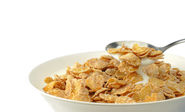
Today we think of cereal as something dyed, sugared, and flavored that comes in a box decorated by a leprechaun or a bunny, but it’s actually one of the oldest foods since civilization began. Grains were first harvested during the Neolithic area, and they were turned into breads, pastes and cereals. Now there are countless varieties of this food, from sugary sap for kids to berry-infused granola for hippies to whole-grain blends for those who have stomach problems. There are also a multitude of ways to eat it – with milk, soy milk, almond milk, coconut milk,yogurt, even plain or made into a granola bar. Whatever your preference is, there is probably a kind of cereal that will suit you perfectly. Just be sure to check the calorie content – the stuff that has sugar added and a bunch of artificial flavor and color is not as good for you as it first appears.
Origin: Dates back to the Neolithic era when people first began harvesting grain. | Taste: Wide ranging, from savory and bland to sweet and sugary. | Calorie Count: depends on the type; average 250-300 calories a bowl with milk | Health Benefits: lots of vitamins A and D, protein, vitamin additives, but varies depending on type of cereal | Pricing: $3-4 per box
Variations: sugary children's cereal, whole-grain adult cereal, granola, many varieties | Pairings: milk, soy, coconut or almond milk, yogurt, fruit | Connotations: grab-and-go, different connotations depending on the style, for example granola calls to mind hippies and the health conscious while Lucky Charms bring up the image of children
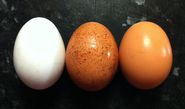
One of the most versatile foods of all time, eggs provide tons of protein and calcium, and can be cooked a bunch of different ways. One boiled or fried egg can be a healthy boost of energy by itself, or they can be scrambled up with cheese, bacon, grits, hash browns, and the whole works. Eggs are also one of the oldest foods mankind enjoys; we’ve been eating eggs since our early hunter-gatherer days when we picked them out of nests, and farming eggs dates back to ancient Egypt, although it wasn’t chicken eggs in this case, but usually wild bird or ostrich. This grew into a worldwide farming industry devoted to harvesting chicken eggs for cooking and eating. Whether you like your breakfast healthy and sparse or completely all-out, eggs are bound to play a part.
Origin: Humans have been eating gathered eggs since prehistory, and farmed eggs date back to the time of the ancient Egyptians. | Taste: Rich dairy, flavor best enhanced with salt or other additives like cheese | Calorie Count: 78 per egg on average | Health Benefits: lots of protein, energy, vitamins A, D and E | Pricing: About $3 per carton
Variations: fried, boiled, scrambled, omelets | Pairings: bacon, sausage, other diner breakfast foods | Connotations: diner food, wholesome breakfast, can be healthy or part of excessive breakfast
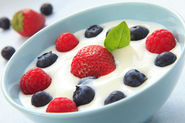
This is another ancient food, dating back to Turkey, Greece and India. Yogurt, spelled “Yoghurt” in Greek, was first discovered when some milk got fermented from plant bacteria, and the results were epic rather than disgusting. Early yogurt was either eaten with honey, which was known as “the food of the gods,” or as a palate cleanser or additive to go with savory foods. It has morphed into a healthy breakfast or snack food, and a great way to add some protein and digestion-friendly probiotics to your day. For a while yogurt was more associated with body builders and women on diets, but since the 2000s with the advent of the parfait (yogurt, fruit and granola) and the reboot of Greek yogurt (a thicker, creamier yogurt that has added probiotic qualities), the breakfast staple has become popular again as a delicious treat for everybody.
Origin: The name is Turkish, yogurt originated in the Neolithic era in Central Asia when plant bacteria contaminated milk | Taste: creamy, slightly sour, hearty | Calorie Count: 61 per serving | Health Benefits: probiotics for digestion, calcium | Pricing: varies depending on quality and type of yogurt, from a dollar to about eight
Variations: Greek, Turkish, flavored, sweetened | Pairings: honey, granola, fruit | Connotations: on-the-go, diet, vegetarian, healthy
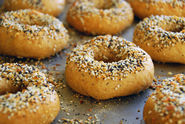
This amazing and completely practical breakfast food originated in Poland, and is associated with Jewish culture. Two hoops of dough are baked and then topped with a schmear, usually cream cheese, although sometimes hummus or peanut butter for vegans. They can also be different flavors, ranging from chocolate chips and berries to garlic and poppy seed. Bagels are so amazing because they are filling and can be grabbed on the go. For that reason, they really took off in New York City, and moved from the Jewish neighborhoods all over the city. In recent years, chains like Einstein Bros. Bagels have opened up, spreading the popularity of bagels to the whole country.
Origin: Polish, Yiddish, associated with Jewish culture | Taste: doughy, often flavored with something like garlic or fruit baked in, usually served with cream cheese | Calorie Count: About 245 per bagel | Health Benefits: lots of calories and carbs, protein in cream cheese | Pricing: $1.50-$3.00 per bagel
Variations: bagel with cream cheese, added salmon, or "lox," peanut butter, hummus | Pairings: goes best with cream cheese as a spread | Connotations: for the business man or working person, a quick bite to grab while out

Pancakes are the ultimate comfort food; they are made of straight flower and egg, and they taste like buttery gifts from God. Many cultures have pancakes, some of which are savory rather than sweet or extremely thin, intended to be used as a wrap for other foods. American and British breakfast pancakes, however, are a special kind; they are big and fluffy, and best served with lots of butter and maple syrup. They can also be fluffed up with awesome additives like yogurt, whipped cream, and fruit. The absolute best thing about pancakes is that they are full of calories, but so filling and delicous that splurging for them is always worthwhile. These are not the healthiest thing you can eat first thing in the morning, but they are awesome as a treat every now and then.
Origin: Dates back to ancient Rome, made in many countries, the English word dates back to the 15th century. | Taste: fluffy, buttery, often covered in butter and maple syrup | Calorie Count: about 64 per cake | Health Benefits: not many, except for daily calories to provide energy in the morning | Pricing: a box of mix is about three dollars, or mix can be made from scratch
Variations: different types of cakes for different regions, thickness and milk or flower used can differ, fruit or chocolate chips can be added | Pairings: syrup and butter, fruit, bacon and eggs, sausage | Connotations: comfort food, diner food, home cooking

The donut needs no introduction; it’s an oily fried cake covered in glaze, frosting, and/or sprinkles or filled with custard and cream. They originated in the late 1700s in America, allegedly a Dutch creation that was initially known as an “oil cake.” Donuts can also have so many variations, from the donut hole with glaze and sugar to the frosted donut covered in cool designs and patterns. By far they are the most unhealthy of all the breakfast foods, but they are also one of the most enjoyable and comforting, and go amazingly with a cup of coffee.
Origin: Specific origins unclear, but invented in American in the late 1700s, probably by Dutch settlers, who referred to them as "oil cakes" | Taste: sweet and doughy, oily, often iced or filled with jelly or custard | Calorie Count: 195 calories – significantly more with fill or toppings | Health Benefits: not many, except for energy and carbs | Pricing: Usually $1-$2
Variations: holes, rings, filled, bars, iced, cake, fried, sugared, glazed | Pairings: coffee, milk | Connotations: Good for meetings, to grab on the go, a treat after a night of drinking
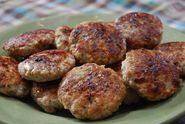
Sausage is a pretty gross concept when you get down to it; basically we are talking the trash parts of the meat shoved into intestine skins. However, they are really tasty, especially depending on what spices are added to the mixture. For breakfast sausage, maple flavoring and other amazing additives get thrown into the mix. They are meant to be part sweet and part savory, so they straddle the divide between the two major breakfast food groups. Breakfast sausage is usually either served in patties or links, and it almost always has a breakfasty flavor. This is definitely not a healthy food, but it’s good and super filling to eat first thing in the morning, and some days you just need to eat some sausage with your eggs and toast.
Origin: Has been around since ancient Rome and the start of butchery - a way for butchers to use the cast-off parts of the animal. | Taste: Rich, fatty, meaty, flavored by a variety of spices, breakfast sausage often contains maple flavoring | Calorie Count: About 143 per link | Health Benefits: some protein, but lots of fat | Pricing: $4-6 per pack
Variations: pork and beef sausage, synthetic or intestine wrapping, patties instead of links, different flavors and seasoning added | Pairings: eggs, pancakes, other typical diner foods, gravy | Connotations: fat, hearty breakfast, wholesome food
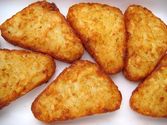
Potatoes can add a ton of nutrition and filling-factor to any meal, and breakfast is no exception. These potatoes were originally referred to as hashed browned potatoes, but this was quickly shortened to “hash browns” as a much easier alternative. They originated in Britain, when soldiers needed an easy meal during WWII, but potatoes have been cooking up for breakfast long before that.Whether you slice up your potatoes, shred them to a fine pulp, or cook them into a cake, hash browns are downright delicious. To make them even better, just add onions, or spice them up with some ketchup or steak sauce. You can’t go wrong, unless of course you don’t like potatoes.
Origin: Originated in American from rösti, a Swiss dish; originally called hashed brown potatoes, but shortened to hash browns. | Taste: salty fried potatoes, similar to French fries, often served with ketchup or steak sauce | Calorie Count: About 470 per serving | Health Benefits: salty and fattening, but some good carbs and vitamins from the potatoes | Pricing: $1-2 per serving
Variations: larger potatoes, small and shaved, served with cheese or veggies, served in a cake | Pairings: ketchup, steak sauce, eggs, steak, bacon, sausage | Connotations: comfort food, diner food, home cooking

This delicious fruit looks so odd because it is actually a hybrid between a Jamaican sweet orange and an Indonesian pomelo. There are rumors that the fruit was created when settlers brought pomelo seeds to Jamaica, but more than likely it occurs naturally. It has been referred to as “the forbidden fruit” because of its bright color, but soon both its harmlessness and nutritional qualities were discovered.This blood-red fruit is an awesome antioxidant and immune system booster, and it goes great with an egg or a spoonful of sugar. It can be enjoyed alone or with just an egg, and it can also be part of a larger and completely satisfying breakfast with all the works. While this fruit is a little bitter and an acquired taste for some, it is a very smart and fulfilling addition to any breakfast.
Origin: Hybrid between a Jamaican sweet orange and an Indonesian pomelo - there are stories that pomelo seeds were brought to Jamaica, but people now believe it was probably a naturally occurring hybrid | Taste: tangy, sour, citrusy, sweet | Calorie Count: 33 per fruit | Health Benefits: tons of Vitamin C, lots of antioxidants to boost metabolism | Pricing: About $1 per pound
Variations: Oro Blanco, Ruby Red, Pink, Thompson, White Marsh, Flame, Star Ruby, Duncan, and Pummelo HB | Pairings: spoonful of sugar, egg, coffee | Connotations: health food, super food, food on the go
